A warm x-country ski can make or break your outing. For the most part, it’s wearing the right layers and bringing enough of them with you in your backpack to put on when you get cold. You’ll want to add extra layers of clothing such as a coat when stopping for a snack or lunch. Your body temperature will cool down quickly when you are no longer moving. Having extra items such as heat packs, a MEC seat cushion and a thermos with some hot tea or hot chocolate can help keep you warm. Gaiters can also do wonders to prevent snow from entering your boots and soaking your socks when skiing in the deep snow.
Table of Contents
Heat packs

Hand Warmers
I find my hands can get cold quickly if I take them out of my mitts to eat food or to take a picture. Even with double-layered mitts, it can take a long time to warm up my hands again. I often make fists with my hands, then open and close them to get the blood circulating while my poles hang behind me as I ski to get warm again.
Tip: To avoid having frozen fingers, I suggest using hand warmers. Open the plastic, take the hand warmers out and shake them. Put a pack in each mitt and they’ll slowly start to heat your mitts and hands for a warm x-country ski. If the pack is too hot on your skin, you can always put the pack between the two layers of mitts.
Foot Warmers
If you get cold feet as well, specifically made foot warmers (different from the picture above) can be placed in your boots to warm them up. I never used to use them, but it would make cross-country skiing more enjoyable on cold days.
MEC Seat Cushion
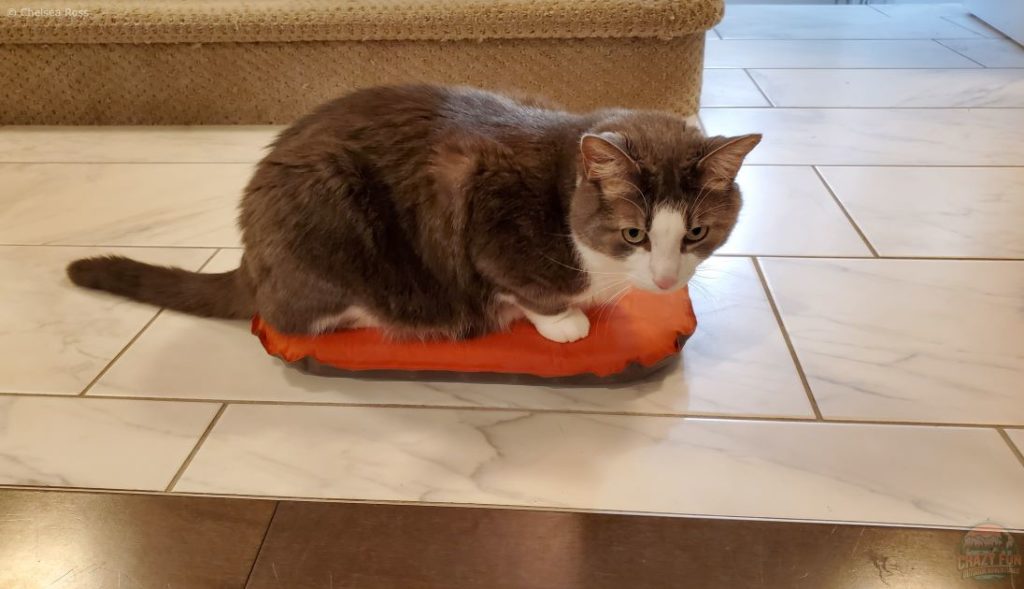
It’s nice to sit outside and have lunch in the great outdoors, but if you have to sit on a cold seat or one that is covered in snow, you might end up frozen. Sitting on mitts can work like I’ve done in the past but they will most likely end up wet afterwards. Meanwhile, your hands will get cold. Normally, mitts aren’t the perfect system, so your butt will get wet anyway. A MEC Seat Cushion is perfect to create a buffer between the seat and your butt and keep your body nice and warm. The cushion is inflatable in a couple of puffs and can be deflated and rolled up quickly for storage in your backpack, once you’re done using it. They have different colours depending on your preference.
Tip: If there is snow on the seat, try to clear most of it otherwise the snow will make the bottom of your cushion wet and create ice. The snow has the potential to reach your butt as well if you put the cushion directly on top of fluffy snow.
This is a useful item that also comes in handy while hiking in the summer such as on Jasper Hikes: Best Memories or 4 Best Larch Hikes in the fall in the mountains. It can be used to avoid sitting on rocky terrain.
Warm X-Country Ski Jacket

I usually wear a fleece and then a thin jacket if the weather isn’t too cold. Wearing a down or synthetic jacket on top can add some additional warmth if the temperature is colder. It adds extra protection against the nippy wind. The bright orange colour helps other skiers see me on the trails, especially in the darker afternoons in December and January.
Tip: A synthetic or down coat can be used instead of a fleece. It’s just as warm to use and way more compatible than a bulky fleece. Keep in mind, that it tends to be way more costly. You might need to save some money to afford it, but it is completely worthwhile.
Neck warmer
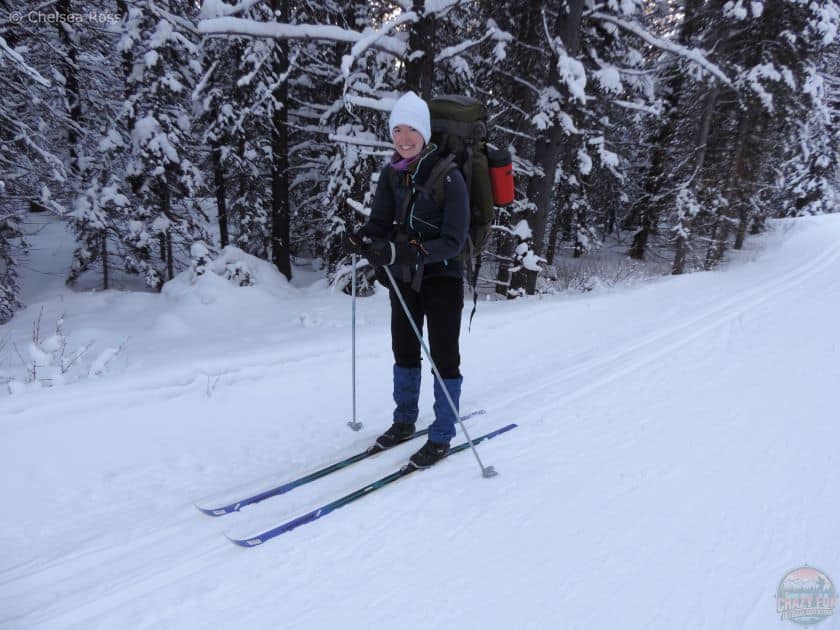
If it’s windy, it can be very cold on the face, therefore cover your neck to keep warm x-country skiing. A Chaos multi-tubular headwear can be very handy to cover your face and neck. It can be adjusted to many different styles. It comes in various colours depending on your preference.
You can have a:
- balaclava (it covers your neck and head and can potentially also cover your cheeks and nose if need be)
- face mask (to cover the nose, cheeks and neck) or
- neck warmer (to cover face or neck, as needed)
Having this essential item is crucial to having a fantastic day of cross-country skiing. It’s nice that it can adjust into different shapes instead of bringing a variety of attire. The Chaos multi-tubular headwear is lightweight to carry around. If you need heavier-weight tubular headwear, those are available as well.
Top and Pant Base Layer
Here are two options of base layers available to you. The top and bottom portions.
Top Base Layer

The Merino 250 Top Base Layer has the same efficiency as the bottom layer. Both are made of the same merino sheep wool material providing sweat and smell resistance with its wicking fabric. It allows your body to exercise in warm and cold temperatures. The slim-fitting Merino 250 Top Base Layer allows you to move comfortably. It never feels like the top is pulling or inching its way up your arm away from your hand. It always seems to be lined up with the end of my jacket. The top is contoured nicely around my body staying in the same place while moving ensuring it doesn’t get bunched up with other layers. It prevents air from getting under the shirt, keeping the body warm. The top is long and covers the waist completely.
The turtle neck provides additional coverage for half of the neck allowing the warm air to be trapped within the top part of your body instead of escaping through the top part of the shirt.
Tip: Wear this top directly against your skin as you can’t feel the zipper on your chest, which is wonderful. For a person like myself who has some sensitivities to touch, I dislike it when I can feel the zipper distracting me while cross-country skiing.
Pant Base Layer
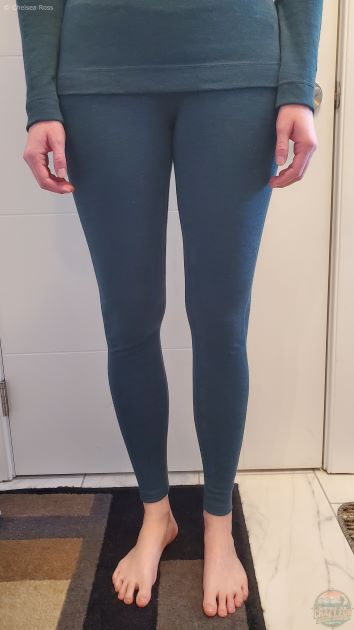
One of the best purchases to keep warm x-country skiing was to buy Merino pant base layer for women. It fits comfortably on the waist with an elastic band without squeezing the stomach. The pants go straight to the ankle allowing a skier to pull on socks with ease and keep legs warm. The pants are nicely woven together preventing the air from entering the pants and causing an uncomfortable breeze while skiing.
Thick socks
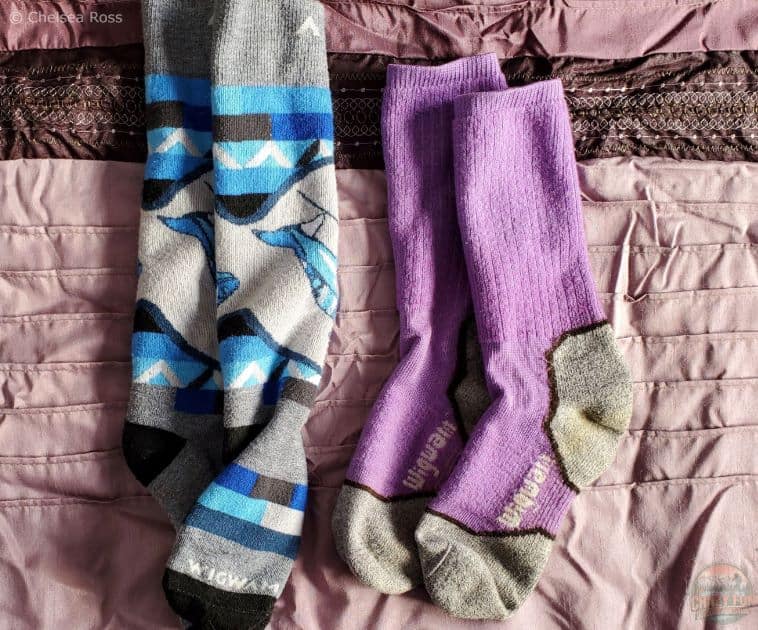
Wigwam socks are warm for cross-country skiing. The cushioning on the toe and heel causes less impact when your foot comes back down on the ski. They fit comfortably along the entire foot.
Tip #1: Having thicker socks on Jasper Hikes: Best Memories will help prevent blisters.
Tip #2: The blue, black and grey socks to the left were a bit tight on my calves. If they go super high up your leg, check that they don’t compress your leg and make it uncomfortable skiing. These socks are typically used for the Best Downhill Ski Day in Lake Louise. Prevent squeezing your calves to avoid thinking about that all day and enjoy your day in nature.
Warm X-Country Ski Pants
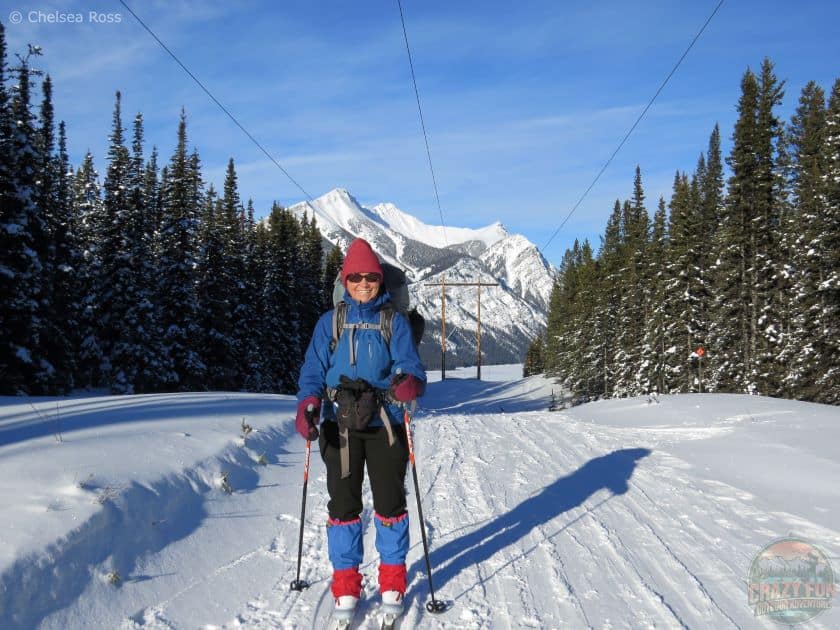
The beautiful sunny and blue sky skiing into Elk Lakes cabin in Peter Lougheed Park makes me appreciate the fun adventure and love cross-country skiing even more. Our warm x-country ski pants made the day wonderful by keeping our legs protected from the elements. It’s always windy at the top of the pass; warm pants make all the difference. Unfortunately, they don’t make these pants anymore. Not sure if many people found them too heavy and hot but contrary to most people, I normally don’t find cross-country skiing pants heavy enough, even by wearing a pant base layer underneath.
Tip: I found these Craft Core Nordic Training Insulated Pants for Kris last Christmas. I’m hoping that they will allow his legs to breathe while cross-country skiing, and keep him warm with the insulated portion.
Fleece Jacket
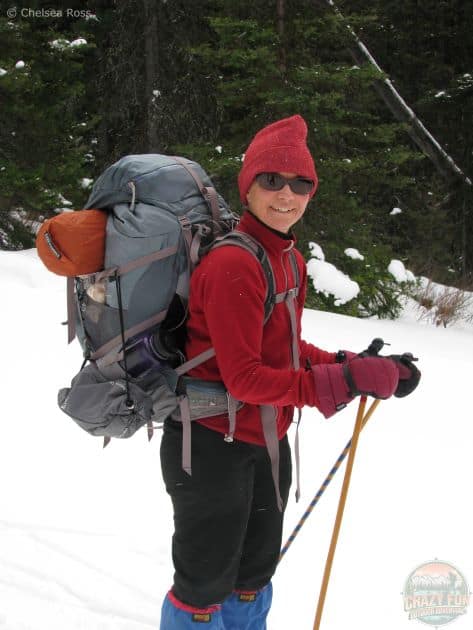
We had a relatively warm day cross-country skiing into Bryant Lake Shelter so that my mom was able to ski in her warm fleece. The backpack causes you to work harder up and down hills making you work out more and potentially sweat. She was warmer because of this combination of factors. The micro-thin fleece ensured she kept warm but didn’t overheat.
We went skiing at La Féclaz in France when the temperatures were mild also, allowing us to wear only a fleece for nicer weather. The fleece can either act as a mid-layer for additional warmth or a top layer to keep you warm while cross-country skiing. It’s nice to have extra layers with you to change in and out of clothing and adapt to the weather conditions along the way.
Gaiters
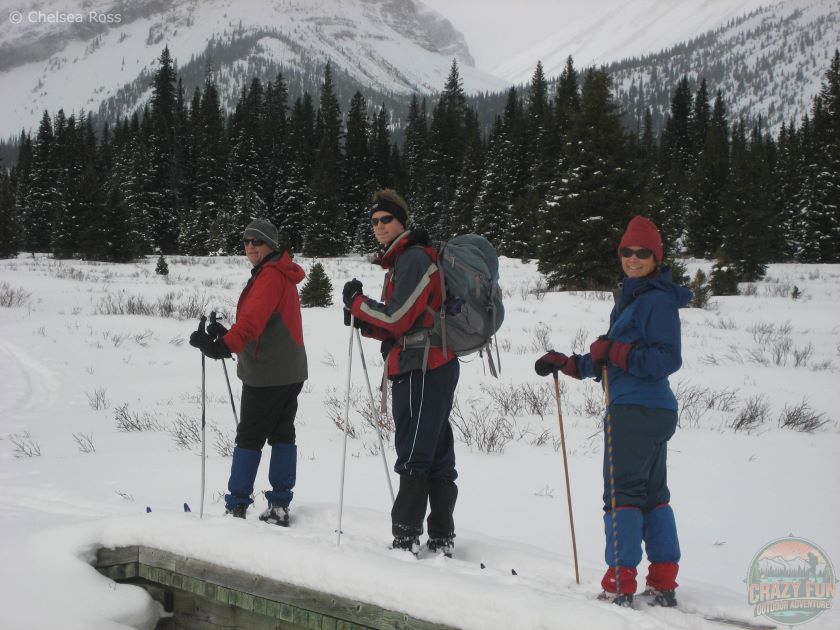
Gaiters are helpful in deep snow. They prevent snow from entering your boots and potentially soaking your socks. Different types of gaiters are available depending on your needs. Some come with zippers and others with Velcro.
Tip: I recommended getting Outdoor Research Crocodile Gaiters for men and women. They cost $79.95 and are worth the purchase. They are easy to wash in the water if they get dirty and feature a hook at the front of the gaiter to attach to your hiking boot or cross-country skiing boot. The gaiters are easily adjustable with the Velcro if you need them to be tighter or looser. It’s strong Velcro ensuring both pieces stay together. Some gaiters have a cord or strap that goes under the footwear, but this type will stay in place with the hook and Velcro.
Thermos

Bring hot tea, hot chocolate, warm water or coffee in a thermos while cross-country skiing. It’s an awesome way to stay hydrated and warm up when taking a snack break. It’s not very heavy and a treat to bring along with you. You can skip out on bringing a cup since you can pour the drink into the top cap of the thermos to drink the liquid. You’ll have to pour more often but it will save you on space compared to bringing a bulky cup. The thermos can be purchased at London Drugs for $27.99. It’s not too expensive and can make for a great addition to your cross-country ski gear.
Final Thoughts
Staying warm x-country skiing can sound so simple but with the wrong gear or not enough layers, it can turn into a miserable trip and experience. Make sure you’re prepared by bringing a tubular headwear to act as a balaclava, neck warmer or face mask. Bring either a synthetic or down jacket if you can afford one, otherwise, a fleece will keep you just as warm. Your top and pant base layers are important to keep your body warm and prevent air from reaching your skin. Make sure to put on an additional layer of ski pants. If your socks aren’t warm enough, you can stick heat packs in your boots and wrap gaiters around your legs. Your butt pad will keep you comfortable when sitting and ensure you can enjoy your lunch while drinking warm beverages from your thermos. Have a great ski and enjoy staying warm!
Additional Links
- XC Skiing Near me
- What are the Benefits of Skiing?
- 10 Reasons to Love Cross-Country Skiing
- 6 Stocking Stuffers for X-Country Skiers
- Downhill Ski Sunshine or Lake Louise?
This post may contain affiliate links. If you purchase through my links, I might receive a small commission, at no additional cost to you. I only recommend companies and products that I’ve used and tested myself. If you’d like to support me, I’d greatly appreciate it! It will help pay for the costs to run my website.

Leave a Reply